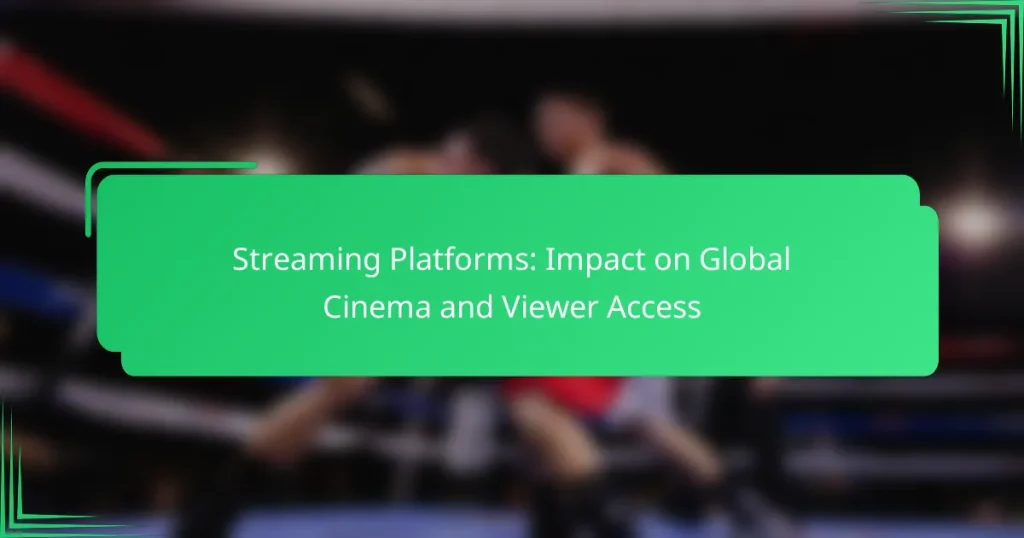Streaming platforms are revolutionizing global cinema by expanding access to a diverse array of films and transforming traditional distribution methods. They allow viewers worldwide to easily discover and enjoy content that may have previously been inaccessible, enhancing the overall viewing experience with the convenience of on-demand access.

How Do Streaming Platforms Influence Global Cinema?
Streaming platforms significantly reshape global cinema by broadening access to diverse films and altering traditional distribution methods. They enable viewers worldwide to discover and enjoy content that may not have been available in their local theaters.
Increased Accessibility for Diverse Audiences
Streaming services enhance accessibility by allowing viewers from various regions to access a wide range of films, including international and independent productions. This democratization of content means that audiences can explore genres and stories that reflect different cultures and perspectives.
For example, platforms like Netflix and Amazon Prime Video often feature films from countries such as South Korea, India, and Nigeria, making them available to global audiences. This increased exposure helps foster a more inclusive cinematic landscape.
Shifts in Film Distribution Models
The rise of streaming platforms has transformed traditional film distribution models, moving away from exclusive theatrical releases to simultaneous or early digital releases. Many films now debut directly on streaming services, allowing filmmakers to reach audiences quickly and efficiently.
This shift can lead to increased revenue opportunities for studios, as they can capitalize on subscription fees and viewership metrics rather than relying solely on box office sales. However, it also raises questions about the sustainability of theatrical releases and the future of cinemas.
Impact on Independent Filmmakers
Independent filmmakers benefit from streaming platforms by gaining access to a broader audience without the need for traditional distribution channels. Services like Vimeo and Hulu often showcase indie films, providing a platform for creators to share their work with viewers who may not visit film festivals.
Moreover, many streaming platforms offer funding and support for original content, encouraging innovative storytelling. However, independent filmmakers must navigate the competitive landscape of streaming services, where visibility can be a challenge amidst a vast array of content.

What Are the Benefits of Streaming Platforms for Viewers?
Streaming platforms offer viewers significant advantages, including easy access to a wide range of content and the ability to watch on their own schedule. These benefits enhance the overall viewing experience, making it more convenient and enjoyable.
Convenience and Flexibility
Streaming platforms provide unparalleled convenience, allowing viewers to watch movies and shows anytime and anywhere, as long as they have internet access. This flexibility means that viewers can enjoy content on various devices, such as smartphones, tablets, laptops, and smart TVs.
Additionally, many platforms allow users to pause, rewind, or fast-forward content, giving them control over their viewing experience. This is a stark contrast to traditional cinema, where viewers must adhere to fixed showtimes and cannot alter the playback.
Variety of Content Choices
One of the most appealing aspects of streaming services is the vast array of content available. Viewers can choose from thousands of movies, TV shows, documentaries, and original programming across multiple genres. This extensive selection caters to diverse tastes and preferences.
Moreover, many platforms regularly update their libraries, introducing new titles and exclusive content. This constant refresh keeps viewers engaged and encourages them to explore different types of entertainment that they might not have considered in a traditional cinema setting.
Cost-Effective Alternatives to Traditional Cinema
Streaming platforms often provide a more affordable option compared to traditional cinema tickets, which can range from $10 to $20 per person in the U.S. Many services offer monthly subscriptions for a flat fee, making it easier for viewers to budget their entertainment expenses.
Additionally, some platforms provide free content with ads, allowing viewers to access a variety of films and shows without any financial commitment. This cost-effective approach enables more people to enjoy cinema from the comfort of their homes, making it accessible to a broader audience.

How Do Streaming Platforms Affect Traditional Cinema Theaters?
Streaming platforms significantly impact traditional cinema theaters by altering how audiences consume films and shifting revenue dynamics. As more viewers opt for the convenience of home viewing, theaters face challenges in maintaining attendance and profitability.
Decline in Box Office Revenues
Box office revenues have seen a notable decline as streaming services become increasingly popular. Many films that would traditionally draw large crowds now struggle to compete with the immediate availability of content online. This trend has led to a decrease in ticket sales, affecting the financial health of theaters.
For instance, during peak streaming periods, box office earnings can drop by 20-30% for certain genres, particularly family films and blockbusters that appeal to younger audiences. The shift in viewing preferences has prompted theaters to rethink their pricing and promotional strategies.
Changes in Audience Viewing Habits
Audiences are increasingly favoring the flexibility of watching films at home over the experience of going to a theater. This change is driven by factors such as convenience, cost savings, and the ability to watch on personal devices. Many viewers now prefer binge-watching series or films at their own pace rather than adhering to a theater schedule.
As a result, theaters are seeing a shift in demographics, with younger audiences particularly inclined to choose streaming options. This trend necessitates that cinemas adapt to changing preferences by enhancing the overall viewing experience, such as offering luxury seating or unique events.
Hybrid Release Strategies
Hybrid release strategies, where films are released simultaneously in theaters and on streaming platforms, have become more common. This approach allows studios to maximize their audience reach and revenue potential. However, it can also dilute the exclusivity that theaters once enjoyed.
For example, major studios may release a blockbuster in theaters for a limited time before making it available for streaming, which can attract viewers to both formats. While this strategy can boost initial box office sales, it may also lead to long-term challenges for theaters as audiences become accustomed to immediate access from home.

What Are the Challenges Facing Streaming Platforms?
Streaming platforms face several significant challenges that impact their operations and user experience. Key issues include content licensing and rights management, market saturation with numerous competitors, and maintaining quality control over the vast array of available content.
Content Licensing and Rights Issues
Content licensing and rights issues are critical for streaming platforms as they navigate complex legal landscapes. Each piece of content often requires specific rights agreements, which can vary by region and may involve negotiations with multiple stakeholders. For example, a platform may need to secure different licenses for films in the US compared to Europe.
Additionally, rights management can lead to content being available in some regions but not others, limiting viewer access. Platforms must stay updated on expiration dates and renewal terms to avoid disruptions in service.
Market Saturation and Competition
Market saturation presents a significant challenge for streaming platforms, with many players vying for viewer attention. As more platforms emerge, the competition intensifies, making it harder for any single service to stand out. This can lead to price wars, where platforms lower subscription fees to attract subscribers, potentially impacting profitability.
Platforms must differentiate themselves through exclusive content, unique features, or superior user experience to retain and grow their subscriber base. For instance, offering original series or films can be an effective strategy to draw in viewers.
Quality Control and Content Curation
Quality control and content curation are essential for maintaining subscriber satisfaction on streaming platforms. With vast libraries of content, ensuring that viewers can easily find high-quality offerings is crucial. Poorly curated content can lead to viewer frustration and increased churn rates.
Platforms should implement robust algorithms and editorial teams to curate content effectively. Regularly updating recommendations based on user preferences and viewing habits can enhance the overall experience. Additionally, soliciting user feedback can help identify gaps in content quality and curation strategies.

How Do Streaming Platforms Shape Viewer Preferences?
Streaming platforms significantly influence viewer preferences by offering tailored content and easy access to a vast library of films and shows. This personalization leads to changes in what audiences choose to watch, often favoring genres and styles that align with their viewing habits.
Personalized Recommendations and Algorithms
Streaming services utilize sophisticated algorithms to analyze viewer behavior, including watch history and ratings, to generate personalized recommendations. This targeted approach not only enhances user satisfaction but also encourages viewers to explore new content that they might not have considered otherwise.
For example, platforms like Netflix and Amazon Prime Video often suggest titles based on similar genres or themes, which can lead to increased engagement. Users may find themselves drawn to niche films or international cinema that they would typically overlook in traditional viewing environments.
Influence of Social Media on Viewing Choices
Social media plays a crucial role in shaping viewer choices by creating buzz around specific films and series. Platforms like Twitter, Instagram, and TikTok allow users to share opinions, trailers, and reviews, which can significantly impact what others decide to watch.
For instance, viral trends or challenges related to a show can lead to spikes in viewership, as seen with series like “Squid Game” or “Stranger Things.” This interplay between social media and streaming not only drives immediate interest but also fosters community discussions that enhance the viewing experience.

What Are the Future Trends in Streaming and Cinema?
The future of streaming and cinema is poised for significant transformation, driven by technological advancements and changing viewer preferences. Key trends include the rise of interactive content, the integration of virtual reality experiences, and the global expansion of streaming services.
Emergence of Interactive and Immersive Content
Interactive and immersive content is becoming increasingly popular, allowing viewers to engage with narratives in new ways. This trend includes choose-your-own-adventure formats and interactive storytelling that can enhance viewer investment in the material.
Platforms like Netflix have already experimented with interactive films, such as “Black Mirror: Bandersnatch,” which allows users to make choices that affect the storyline. This format not only attracts a younger audience but also encourages repeat viewings, as users explore different outcomes.
Integration of Virtual Reality Experiences
Virtual reality (VR) is set to revolutionize how audiences experience cinema by providing fully immersive environments. VR allows viewers to step inside a story, making them active participants rather than passive observers.
Streaming platforms are beginning to offer VR content, which can be accessed using compatible headsets. As technology improves and becomes more affordable, the adoption of VR experiences in mainstream cinema is likely to increase, enhancing storytelling and viewer engagement.
Global Expansion of Streaming Services
The global expansion of streaming services is reshaping the cinematic landscape, making diverse content accessible to audiences worldwide. Services like Disney+, Amazon Prime Video, and local platforms are competing for subscribers in various regions, often tailoring their offerings to local tastes.
This expansion not only increases competition but also encourages the production of regional content, reflecting cultural diversity. As streaming services continue to grow, they will likely invest more in original programming that resonates with local audiences, enhancing viewer access to varied cinematic experiences.


